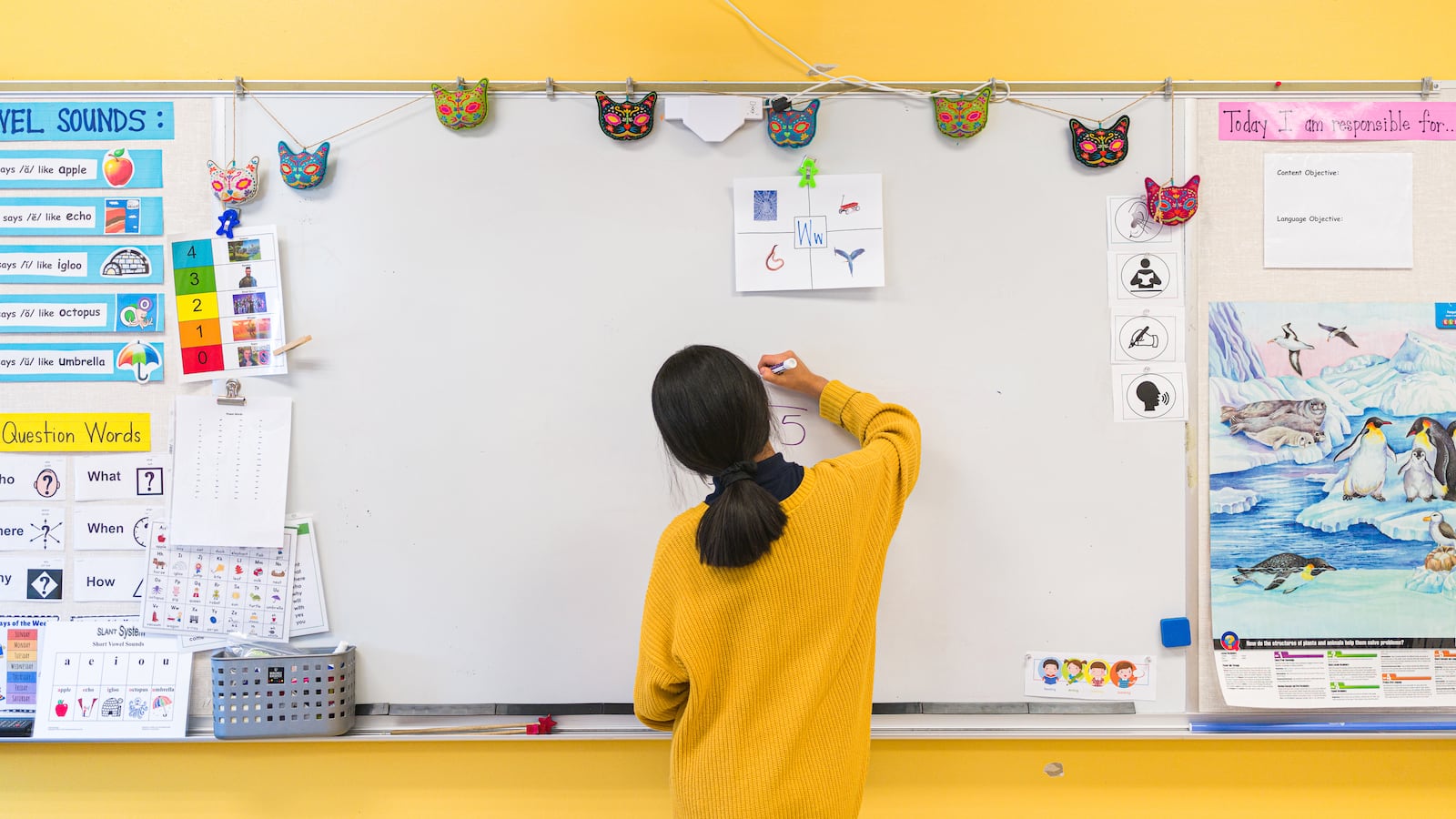As Guillermo Benitez moved through a lesson on ratios, he pressed his sixth-graders to elaborate at every turn: How did we get that answer?
The math teacher gave some students a heads up first, knowing it’s helpful not to put English learners on the spot. Along the way, Benitez kept a mental tally of who hadn’t spoken up yet.
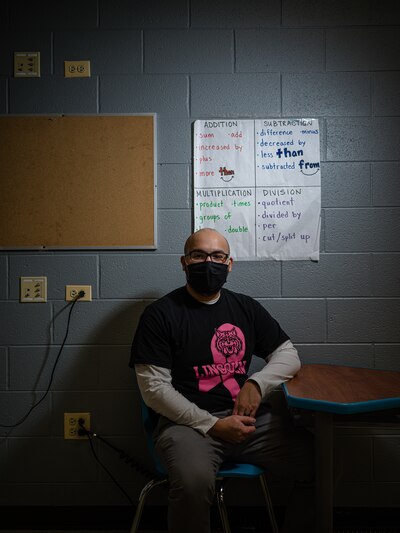
“I’ma call on you to explain something to me,” Benitez nudged one student. “You’re the only one I haven’t called on today. Your time’s coming. Are you prepared?”
“No!” the student said, with a giggle.
Earlier in the period, Benitez let students work out problems in groups of three before they shared with the whole class — another way of helping students prepare to participate. He leaned over the desk of a student who hadn’t spoken up in her group.
She began to explain how they arrived at 14, softly. “Good,” Benitez told her. “That’s how you show your work.”
For many teachers of English learners like Benitez, working with students to build oral language skills has been especially crucial this year.
That’s because remote learning made those skills harder to practice last year. A report released this month detailed some of the common challenges: Students had fewer opportunities to talk with their classmates online, and teachers who specialized in language support often got pulled away to help with other duties. The charts and word banks that students rely on as they learn to speak a new language were harder to share in virtual classrooms, too.
“Kids, especially younger kids, just did not have opportunities to use language in the way that they normally do,” said Amaya Garcia, a co-author of the report who researches education policies that affect English learners for the think tank New America. “For a lot of the people that we spoke with, that was a real area of concern.”
Those issues showed up on the test that many states use to measure the progress of students learning English. Across the U.S., including in Benitez’s school district, a smaller share of students reached their English language proficiency goals than usual last spring, especially in the younger grades. Scores dropped the most on the writing and speaking portions.
To help students make up for lost time, school districts like Berwyn North, where Benitez teaches just west of Chicago, are focused on boosting English learners’ speaking skills with new tactics, more coaching, and even new furniture arrangements.
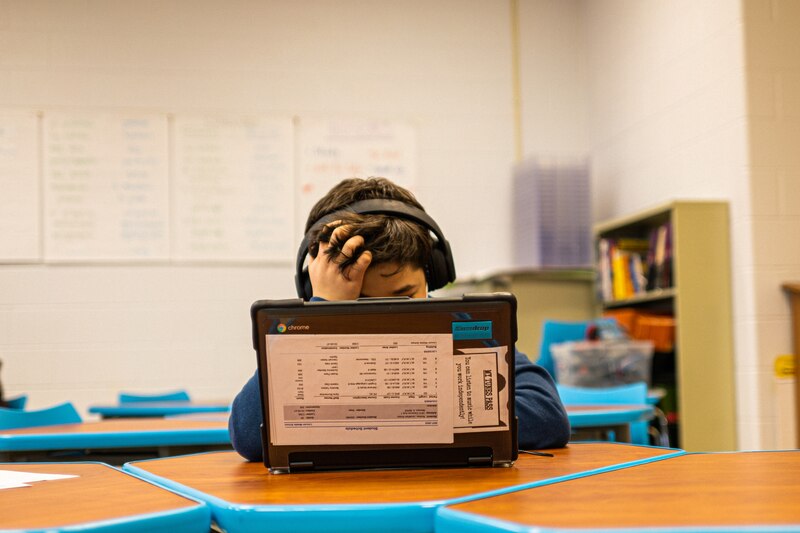
“That was very important for them to practice that conversation piece,” said Francela López, who oversees services for Berwyn North’s English learners, who make up a third of all students in the district. “They did miss out on some of that.”
Like many districts, Berwyn North schools had a tall order before them last fall. It marked the first time most students returned for in-person learning after more than a year. Though the district reopened buildings last spring, few students came in. Most English learners got language support over Zoom, but few were able to practice their English outside of class, López said.
Dana Sartori, an elementary school teacher who’s worked in the district for two decades, noticed that when they returned, many younger English learners were quieter than usual.
“It’s like you have to pull words out of them,” Sartori said in an interview in December. “I always thought that all the kids had silent periods, but this is different.”
To help, Sartori has tried to boost her students’ confidence. One morning that month, she stopped by the desk of an English learner in third grade wearing sparkly silver shoes whose voice barely rose above a whisper.
Sartori knew the little girl often stayed quiet because she struggled to read, so Sartori read the lesson aloud with gusto and asked the student to tell her about it. The third-grader’s voice rose up a notch. “It was louder because she felt comfortable and confident in what she was telling me,” Sartori said.
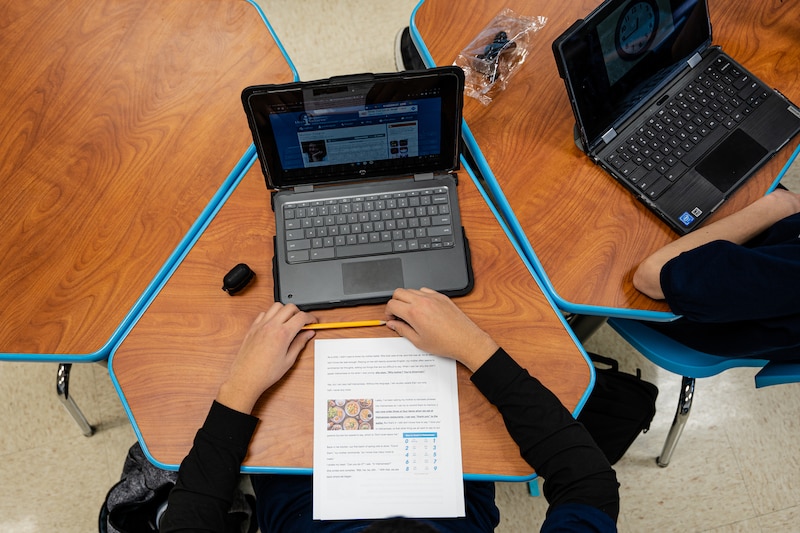
Educators have looked for ways to get students talking more to one another, too. Early in the school year, for example, López and a colleague helped teachers figure out how to set up new hexagon-shaped desks to encourage students to turn and talk with a classmate.
Teacher coaches have helped teachers add more speaking practice into their lessons, too. It’s something they did before the pandemic that’s taken on added significance this year.
One day in December, fifth-grade teacher Anne Vaccaro tested out a new activity that gave each student a different speaking role. Students pushed their desks together into groups of four and took turns asking and answering science questions about the atmosphere, weathering, and erosion.
Conversations filled the room. At one table where a little boy wasn’t saying much, a classmate tried to help him explain how erosion breaks down cliffs, while he nodded along — the kind of natural interaction that had been difficult to replicate online.
Some students glanced down at a piece of paper filled with phrases such as “What do you mean when you say that?” and “Can you tell me more?” Getting students to elaborate on their thinking like that has taken a little longer this year, Sartori said, but by winter, she was starting to see it stick.
“What I liked about interacting with my classmates was that I could share my ideas,” said one especially enthusiastic student.
Teachers also got more training on how to use Flipgrid, a tool that allows students to record themselves speaking, listen back, and get feedback. Sartori uses the tool twice a week in an extra support class for a handful of struggling English learners, though sometimes it hasn’t elicited the response she was looking for.
“Remember, you’re talking as much as you can!” Sartori told her three students that day. She wanted them to look at a picture of a young boy playing soccer and describe how he might be feeling.
“OK, when you’re ready!” Sartori said. None of the students spoke.
Sartori moved around the room, trying to help. She offered to turn off the camera so students wouldn’t see their faces. She provided some sentence starters and rehearsed what students might say. One student wrote his answer on a Post-it, but he didn’t want to say it.
“You’re being shy? What’s going on?” Sartori said. “You’ve done this before!”
For one 9-year-old, who rarely talks in her larger classes, the lesson felt hard. She prefers working in teams and doing activities that feel more like games, she said.
At home, she said in Spanish, “I talk a little more because I feel more comfortable there.” But at school, “there are a lot of people I still don’t know and it makes me nervous.”
The district is also serving a larger number of newcomer students this year, mainly from Mexico, Colombia, Chile, and Morocco. Some students arrived a few months ago, while others started school just before the pandemic but didn’t attend many virtual classes last year.
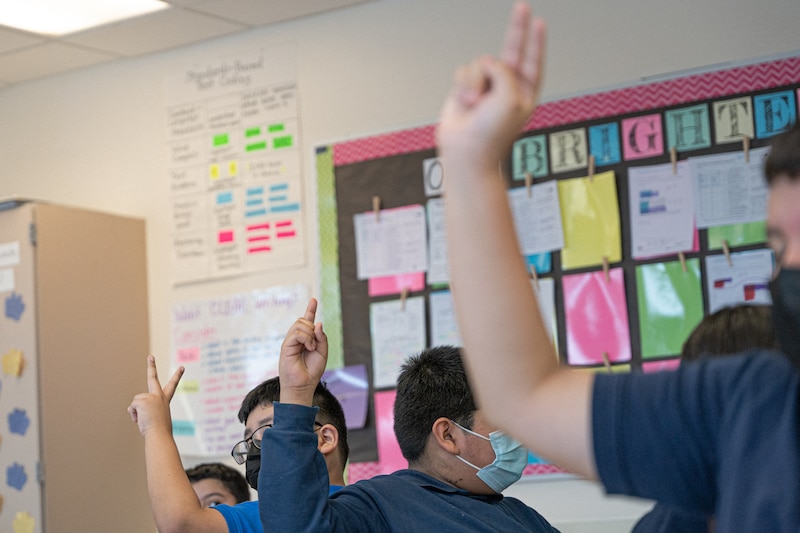
To support those students at the middle school, teacher Hannah Nolan-Spohn created a small class in February specifically for newcomers with six Spanish speakers and two Arabic speakers.
It’s a one-hour class where students can get more consistent language support. Nolan-Spohn, who specializes in working with English learners, sets aside time every Tuesday for students to talk with their classmates, and she’s teaching them phonics so they feel confident in their pronunciation. She also tries to pick activities that will resonate with students, like listening to an audio story about a Vietnamese-American woman trying to maintain a connection with her mother’s language.
“I’m hoping that will continue to make them feel safe,” she said. “This is the place to make mistakes and take risks because everybody’s in the same boat as you. No one’s going to tease you. It’s OK if you mispronounce something. This is the space to try.”
Already, she’s built an atmosphere where students feel comfortable joking with each other. At the start of a lesson in mid-February, one student led the class in a daily speaking activity about the day and the weather. She teased her classmates when she didn’t get much of a response.
“Are they asleep?!” she asked Nolan-Spohn.
After a winter of pandemic hiccups — including a spike in student and teacher absences that pulled some English learner specialists away to sub — López is hopeful English learners will make more progress this year.
Last year, around 6% of English learners in the district scored high enough on the proficiency test to exit the program, though typically it’s between 7% and 9%. Educators are hoping it will be closer to 10% this year.
“I think we are moving along,” López said. “Our goal is to see some growth.”
Garcia, at New America, expects speaking scores will be higher this year, now that students have had more time to talk with their teachers and classmates in person. And with more information in hand, she wants schools to pay particularly close attention to English learners’ progress.
Last spring, school districts were able to test a much smaller share of their English learners than usual — Berwyn North reached around 60% — so teachers had less information to work with. This time around, teachers will know a lot more about what support students need and what they can do.
“To me, this is the level-setting year,” Garcia said. “Now we need to figure out how to adjust what we’re doing to address what we see.”
Kalyn Belsha is a national education reporter based in Chicago. Contact her at kbelsha@chalkbeat.org.


